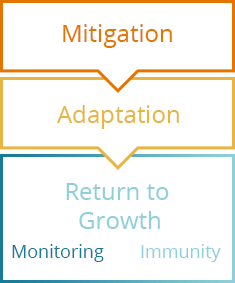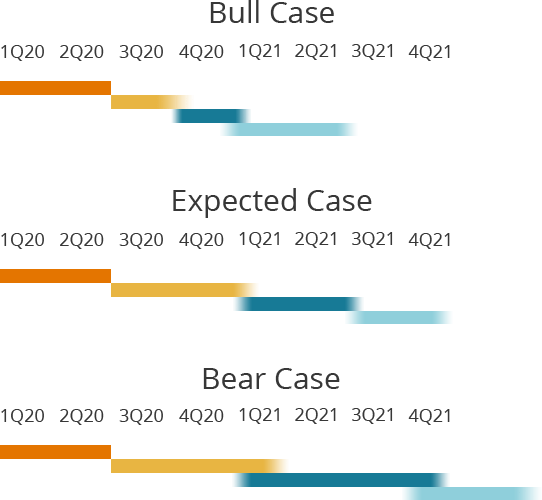Framing the Challenge
The next twelve months can best be described as uncertain. There is a lot we do not know about the COVID-19 virus: how governments will react, how businesses will stay afloat, and what kind of messaging empathizes but does not pander. For some industries, the forced shutdowns and the gradual reopening has required businesses to compress a decade’s worth of digital innovation into a few months.
While this disruption has caused immense harm, this forced transition can be viewed as constructive. If taken seriously, this could help transform the way older, stodgier, firms operate and result in improved client and employee experiences. The goal of this article is to provide a framework for how to prepare your firm to be successful throughout this downturn.
In a normal environment, the digital shops that we work with have decent visibility into their business outlook for about six to nine months, meaning they are confident forecasting the revenue coming in and the expenses flowing out during that timeframe. Current events are now clouding outlooks and have reduced visibility down to about three months. This combination of increased uncertainty and lowered visibility can be paralyzing to businesses, but the cost of inaction can be tremendous.
Firms that take decisive action earlier have a better chance of success than those that “wait and see.” But how do you determine the right direction to run when you are not sure where the pitfalls are? The best advice we can give is to not let the perfect be the enemy of the good. A firm that compresses its feedback loops to collect and process information more quickly and acts decisively on that information will have a substantially easier time adapting to this changing environment.
A firm that compresses its feedback loops to collect and process information more quickly and acts decisively on that information will have a substantially easier time adapting to this changing environment.
The Phases of the Downturn
This guide focuses on the high-level trends that we are seeing in the current environment and how dev shops, design shops, and digital marketing agencies can navigate this situation. For a deep dive into our thinking on the phases of this recession, its depth, significantly impacted industries, and the government’s relief efforts, see our latest writeup: Multiple Phases, An Industry Minefield, & All the Cash the Fed Can Print: A deep dive into the new pandemic economy.

Mitigation
The Mitigation phase, when the first shocks to sales pipelines hit and disruption spreads throughout the economy.
Adaptation
The Adaptation phase, when uncertainty falls slightly, and businesses begin to adapt to their new normal.
Return to Growth
The Return to Growth phase, when the broader economy begins to recover and uncertainty falls over time to a normal level.
Expected Timing
The Mitigation phase should be over by the end of the second quarter 2020. Most firms exited this phase in early 2Q20, but some firms and industries lag behind the norm.
The Adaptation phase will likely last through the second half of 2020. Economies are partially reopened quickly as the shutdowns spelled serious trouble for state and local governments, but the threat of a resurgence in infections is preventing them from fully reopening (and could cause the Adaption phase to last longer than expected). The duration of this phase, and the start of the Return to Growth phase is unclear as they are predicated on medical advances that we cannot forecast.
Given what we know now, we would expect to enter the Return to Growth phase in late 2020 / early 2021. Again, this transition relies fully on new therapeutics coming online which the timing of is impossible to accurately forecast. As these therapeutics are developed and implemented, more of the economy will be able to recover. Once a vaccine is developed and distributed broadly, we will transition from Monitoring to Immunity and a full return to growth will be possible.

Steps to Take Based on the Phase of the Downturn
There are general steps that a dev shop, design shop, or digital marketing agency can take that can help them emerge from this downturn in a stronger position than their peers. Note that these are general tactics and not all of them may be applicable to your specific situation.
Mitigation
Goal: Compress feedback loops and put plans in place that ensure the survival of the business.
This is the phase with the highest uncertainty. Many firms are in triage mode – sales forecasts fall, budgets are slashed, new project investment is halted, outside vendor relationships are reduced or eliminated, and staff reductions are enacted. Fear has gripped a large portion of the market due to this uncertainty. It is critical to remain logical and to act deliberately. Tighten feedback loops so you can act on information more quickly. It is likely this will be the most challenging phase of the downturn and the actions you take here will either limit or expand your options in later phases.
Action Items
- Get the executive team on the same page. Everyone needs to understand the severity of the situation – the firm’s financial position and the required actions to take.
- Move to a fully remote team.
- Shore up your cash reserves. The Federal government announced a loan program for businesses. This is something to investigate immediately. Portions of these loans can be forgiven if the capital is used to keep employees on payroll. We typically see firms carrying 2-3 months of operating expenses in cash on hand, in this environment we recommend increasing this to 6 months and 9-12 months, if possible.
- Examine your employee headcount and create a plan. Reductions in headcount are difficult, but this should be viewed as a time to be critical about your business. Everyone who keeps a seat needs to be there for a reason. Have a plan for when (if any) these cuts need to take effect. Identify the individuals critical to rebuilding the firm if it comes to that.
- Cut unnecessary expenses. All operating expenses should be evaluated.
- Keep connecting with your key accounts on a regular basis. Things change quickly during this time, so it is important that you obtain and act on changes. Staying in contact with primary clients can provide advanced warning of any pauses in work, cuts in spending, or delayed payments.
Adaptation
Goal: Adapt the business to fit in the changed landscape and begin to take advantage of opportunities.
By this phase, the initial shock has worn off. Things still are a long way from normal, but the fire is manageable. The way the world works has changed. For many things, this will be a temporary new normal, but for some areas the changes could likely become permanent. By this time, the necessary actions have been taken to keep your business going, maybe not thriving, but you are still in the game.
This is the phase where you take a deeper dive into operations, services offered, and ideal client profiles. This is also the time where opportunities will begin to present themselves. Many firms have reduced headcount during the Mitigation phase thus making quality talent more available. Some firms did not make it through the Mitigation phase, leaving potential openings at their old clients. Some firms that made it through the Mitigation phase are still not seeing their outlooks improve and are looking for an exit. If you have positioned yourself well, this could be an opportune time to begin looking at acquisitions (both people and company). If the business has stabilized quickly, use this phase to set your firm up for success during the Return to Growth phase.
Action Items
- Continue to keep management in a tight loop surrounding the outlook, maintain above-normal cash reserves, and keep in regular contact with key accounts.
- Reevaluate your service portfolio. Ask yourself if it makes sense to spread your focus across those services, or if you should be looking at moving in other directions.
- Take a critical look at your organization chart. If headcount reductions were necessary, are the right people there now to serve current and future clients and are they focused in the right areas?
- Reexamine your go to market strategy. Buying habits have likely changed significantly, industry focuses have shifted, and prospects may have different concerns now than they did six months ago. This requires a full reevaluation of your marketing, sales, and account management strategies and activities. “Business as usual” can be disastrous here.
- If above-normal (greater than 3 months of operating expenses) cash reserves have been maintained – create and begin executing a plan to invest the excess. It is critical to grow strategically here as this can be the catalyst that enables greater long-term growth in the future.
Return to Growth
Goal: Press the gas pedal on growth and take advantage of a broad rising tide.
During this phase, the economy begins its return to normal. It starts with most businesses beginning to recover, but the lack of a vaccine prevents everything from reopening. Once a vaccine is developed and widely disseminated, the broad economy can return to growth.
During this time, the health of businesses and industries varies greatly. Some were well positioned before the pandemic, acted decisively during the Mitigation phase, were able to take advantage of opportunities during the Adaptation phase, and are now in a rapid growth stage. Firms that were poorly positioned and slow to implement changes during Adaptation phase, now have significant work to do to rebuild their businesses. Those remaining will lie on a broad spectrum between these two extremes and the correct course of action will be dictated by where your firm falls.
Action Items
- Ensure your firm is on solid financial footing.
- Shore up your go to market strategy.
- Implement a repeatable revenue generation system. [see our guide]
- Examine your operating expenses, primarily employee costs, and make sure you have the right people in the right seats for the right price.
- Reexamine your operations again and compare them with the changes in the marketplace that were permanent versus those that were temporary.
- Do the same with the firm’s positioning.
- Take advantage of opportunities early as the longer the recovery goes on the smaller and rarer these become.
- Hire great talent.
- Examine M&A possibilities.
- Return to growth.
Industry Outlook
By understanding the sources of risk and areas of resiliency in various industries, you will be able to make better decisions during each phase of this downturn. Here we are sharing our views on the most and least attractive industries. Use this section to plan your go to market strategies during each phase.
High-risk Industries
This recession is hitting many industries hard, but we believe some will fare significantly worse than others. These will have both deeper and longer downturns and selling into them will become more difficult.
Low-risk Industries
While most industries will see significant negative impacts from this pandemic, we expect a few will see a positive impact. Positioning your firm to take advantage of this will allow you to better withstand this disruption.
Review our deep dive into the new pandemic economy for our full Industry Impact Forecast.
Opportunity from Disruption
The best way to look at this painful situation is that disruption breeds opportunities. Our goal is to position firms in such a way that lets owners take advantage of these opportunities. Not every action item in this guide will be applicable to your situation, but this is generally the same advice we have been giving clients throughout this pandemic. Hopefully, this helps you make more informed decisions that allow you and your employees to exit this downturn in a positive way.






